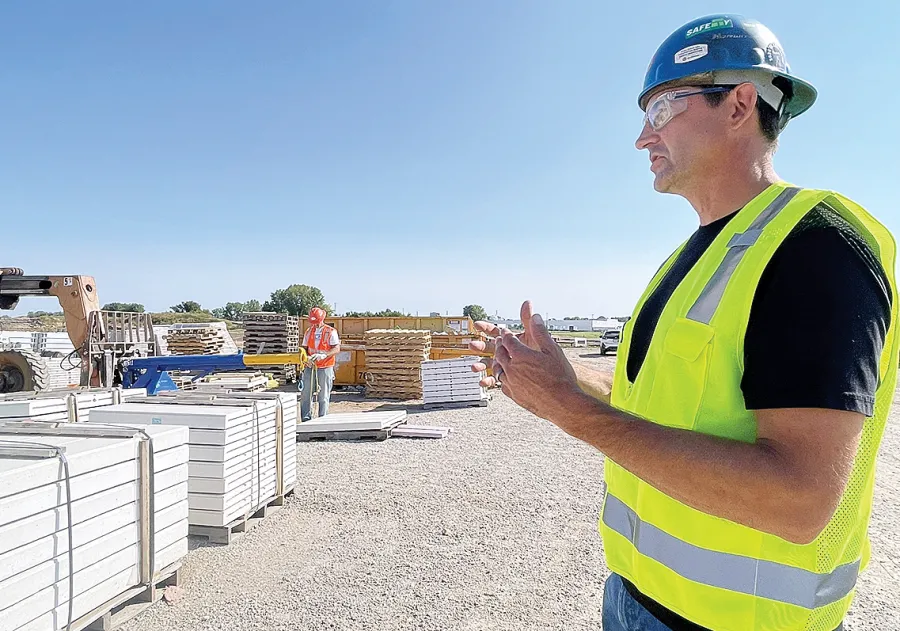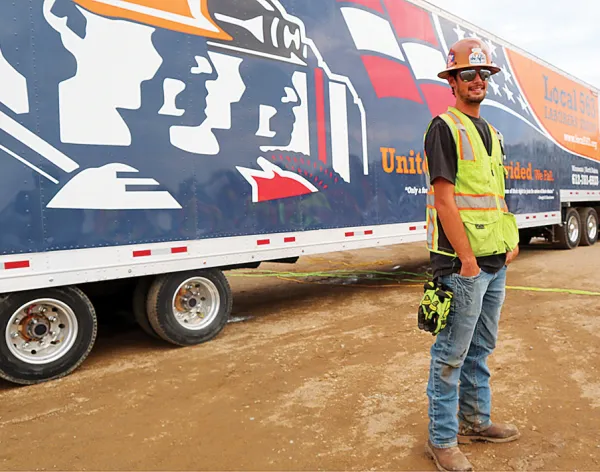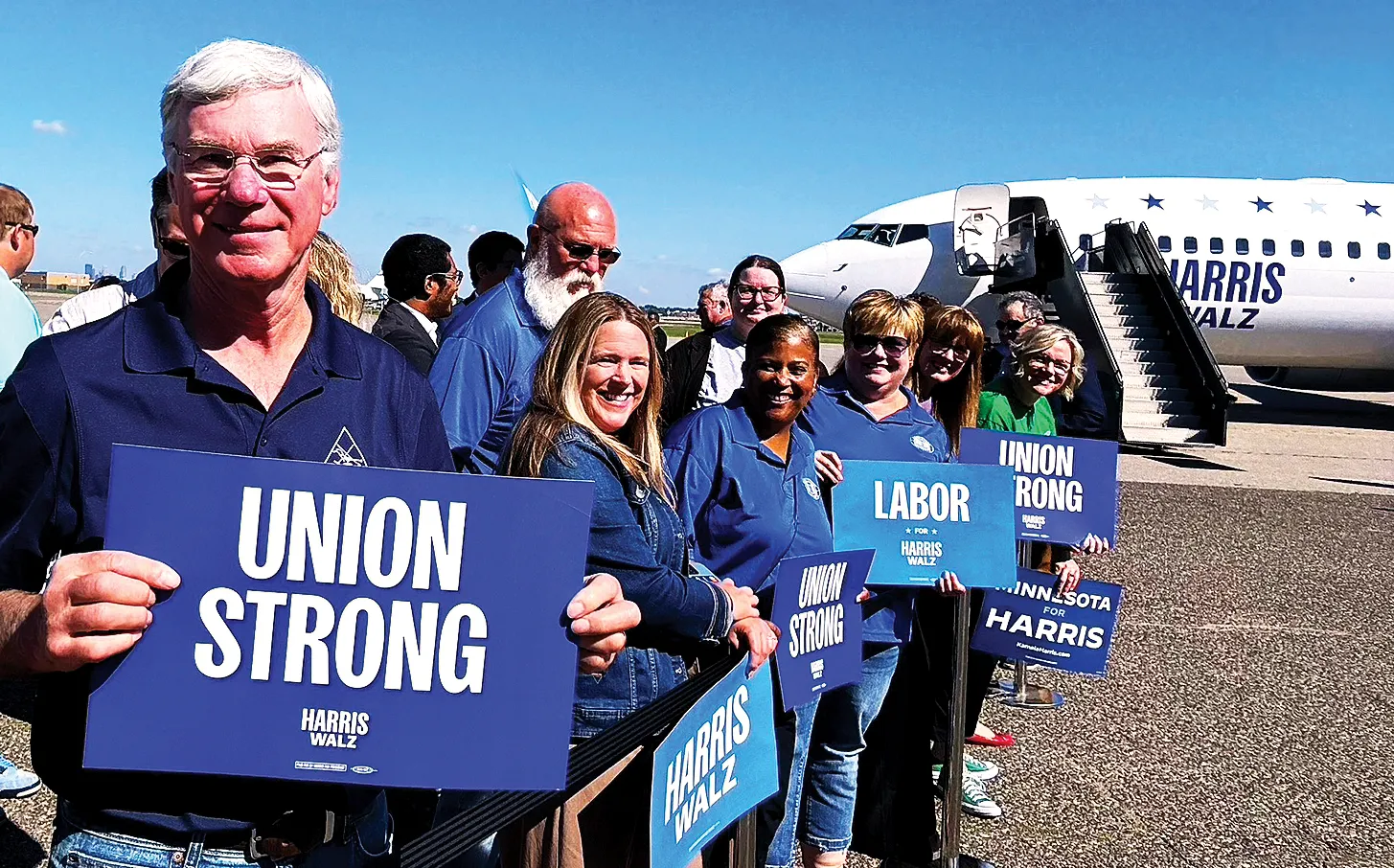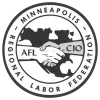THE RACE FOR THE WHITE HOUSE, Part 2 of 3: Workers, families are focus of Harris-Walz agenda

Photo above: Steve Plieseis, member of Pipefitters Local 539, is general foreman at a job site in Maple Grove, one of hundreds of construction projects benefiting from $6 billion in Biden-Harris infrastructure spending. — Jean Hopfensperger photo
Second in a series
By Jean Hopfensperger
Special to the Minneapolis Labor Review
MINNEAPOLIS — Steve Plieseis is general foreman at a sprawling Boston Scientific technology center in Maple Grove. The construction project he works at every day is among hundreds across Minnesota benefiting from $6 billion in infrastructure funds approved for the state under the Biden-Harris administration. These projects are among the many reasons for labor’s solid support behind the Harris-Walz presidential ticket.
Now the question is, what kind of economy would Kamala Harris build if she becomes president, Plieseis asked.
“I think a lot of people are wondering what’s next,’’ said Plieseis, a 22-year member of Pipefitters Local 539. “Infrastructure is absolutely needed and it provides good paying jobs. But some people still aren’t sure what she stands for. It doesn’t help that [former vice president Donald] Trump continues to spread a vicious cycle of misinformation.’’
As the race to the White House kicks into high gear, Harris is forging a path that balances the pro-union legacy of President Joe Biden with her own agenda for the future.
Harris has won endorsements from the AFL-CIO, AFSCME, the American Federation of Teachers, North America’s Building Trades Unions, SEIU, the United Auto Workers and nearly every major trade union in the nation.
But while the Biden-Harris administration ushered in low unemployment and broad economic growth, its successes were not top of the minds of voters. The cost of groceries, housing and inflation were priorities, polls showed. Harris and running mate Governor Tim Walz say they are now making high living costs their top priority, too.
“Bring down costs”
In a much-publicized campaign speech in North Carolina last month. Harris acknowledged that in spite of the nation’s strong economic growth “many Americans don’t yet feel that progress in their daily lives.’’ She rolled out her plans to “bring down costs” and ease the strain.
They include up to $25,000 in downpayment assistance for first-time home-buyers, and tax breaks for builders who construct starter homes. To help young families, she promoted $6,000 in tax relief to low and middle-income families to support their newborns during their first year. She also pledged to restore a $3,600 child tax credit for other preschoolers.
To help workers keep more of their wages, Harris vowed to cut taxes for lower and middle class workers, and exempt tips from federal income tax. (Trump also pledged to end taxes on tips.) She said she would lower drug prices for Medicare recipients. She suggested a federal ban on corporate price gouging by major food producers and grocers — an idea which quickly generated controversy.
“Costs are still too high,’’ Harris said during the August 15 rally. “And on a deeper level, for too many people, no matter how much they work, it feels so hard to just be able to get ahead.”
All the measures would require approval by Congress.
For union members such as Plieseis, the Harris proposals hit close to home. He said his son recently endured the “long and difficult journey’’ of finding an affordable starter home, which he says “don’t seem to exist.’’ And his daughter has a newborn and is coming to grips with the enormous cost of fulltime childcare, which averages $12,200 a year for preschoolers in Minnesota, state reports show.
“I’d agree with it all,’’ he said of the Harris agenda, especially the price gouging plan. “If you want to point to something driving inflation, it’s that.”
In contrast, two days before Harris shared her plans, Trump addressed a crowd in North Carolina during a speech billed as his economic plans. He said energy prices were driving up the cost of living, and he would cut energy and electricity prices by “unlocking new lands for drilling” and cutting regulations on energy production. He claimed he would cut energy prices “by at least half’’ within 18 months of taking office.
But strangely, Trump added: “If it doesn’t work out, you’ll say, ‘oh well, I voted for him and he still got it down a lot.”’
Trump promised to extend his 2017 tax cuts scheduled to expire after 2025, which most strongly benefited high income households and corporations. He would impose sweeping new tariffs on imported goods to the United States, which economists say would lead to higher prices for American consumers. He supports ending taxes on Social Security and tips. He also spent considerable time insulting Harris and arguing that the economy is in ruins.
Both Trump and Harris plans would require billions of dollars in funding, which has not yet been clearly identified.
Many workers are still waiting to reap the benefits of Trump’s tax cuts and policies.
“My taxes went up since he [Trump]gave me a ‘tax break,’’’ said Paul Batsche, assistant business manager at Pipefitters Local 539. “I had to dig into my savings to pay them.” Batsche said further of Trump: “He’s filed for bankruptcy a couple times. He’s stiffed people who worked for him. He’s not for the middle class.”
“For the past four years, working people have had a champion in the White House,’’ emphasized Kris Fredson, public affairs director for LIUNA Minnesota and North Dakota. “It will be large corporations and the rich that have champions if Trump is elected.’’
In Minnesota, a $6 billion investment from Biden-Harris infrastructure projects will roll out over the next decade, creating good-paying jobs for laborers, electricians, sheet metal workers, carpenters and other trades, as well as launching and sustaining the careers of the many apprentices whose hiring is part of the package.

In Minnesota: $6 billion, 450 projects
The Biden-Harris labor legacy is an ongoing gift to the Harris campaign on many levels. Perhaps the most visible are the high-profile projects funded by the infrastructure law.
Walk by the historic Stone Arch Bridge in Minneapolis and you’ll see construction crews repairing the walls and bottom arches. Rush through the Minneapolis-St. Paul International Airport, and you’ll find the north gate and passenger bridges being built. Drive on any number of highways and see bulldozers widening the roads. If you’re heading to the North Shore, it’s hard to miss the massive $1 billion rebuild of the bridge connecting Duluth to Superior Wisconsin, which typically serves 33,000 cars a day.
So far 457 Minnesota projects have received funding, typically part of broader government funding and/or corporate investments. More will roll out in the years ahead. John Kappedahl-O’Brien, a decade-long member of LIUNA Local 563, says the projects’ impacts on labor and communities can’t be overestimated.
“It’s a win-win situation,’’ said Kappedahl-O’Brien, a labor foreman at the Sherco solar energy project in Becker, which when completed, will be the largest in Minnesota.
For starters, about 350 union members now have jobs at the Sherco solar project with good paying wages and benefits, he said, and there will be more in the future. Those wages support their families and flow to local businesses. The solar plant, when completed, is slated to produce power for 100,000 area homes, lowering homeowners’ energy bills. And all this is happening with renewable energy.
“But if the next administration doesn’t want renewable clean energy, they might put an axe to this,’’ said Kappedahl-O’Brien. “That’s what I’m worried about.’’
The Biden-Harris infrastructure projects will roll out over the next decade, creating good-paying jobs for laborers, electricians, sheet metal workers, carpenters and other trades, as well as launching and sustaining the careers of the many apprentices whose hiring is part of the package.
“Biden and Harris are the reasons the infrastructure spending bill passed,’’ said Fredson. “We need to make sure Harris is in the White House so those investments will continue. Kamala Harris will pick up where Joe Biden left off in terms of being a champion for working people.”
Trump had campaigned on a $1 trillion infrastructure plan in his bid for the White House in 2016. But his plan never got off the ground. As President Biden likes to say: “Donald Trump promised infrastructure every week for four years and he never built a damn thing.”

The Walz effect
Minnesota labor leaders like to think they may have played a small part in getting Minnesota Governor Tim Walz on the Democratic ticket, a choice that has galvanized labor support in Minnesota and across the country. As Harris was evaluating her running-mate contenders, more than 25 state union leaders signed an open letter “To Whom it May Concern,’’ urging Harris to choose Walz as her ticket’s vice president. The two-page letter, sent July 29, ends:
“Governor Tim Walz should be the next vice president of the United States. He has a biography and legislative accomplishments that deliver key states. He will walk into any forum as an effective spokesperson for working people. He has a demonstrated talent for exposing the opposition as liars, race-baiters and just plain “weird” (his word). Finally, we know him well enough to say he will be a trustworthy and loyal counselor to President Harris and her administration.”
A dozen of those labor leaders then held a press conference at the state capitol, arguing the same.
“Interesting enough, he got chosen,’’ said Jim Gleb, recently retired president of United Food and Commercial Workers Local 1189, who was among those who signed the letter and attended the press conference.” We thought he’d be a good choice. He’s done so many things for this state that are important. It would be nice to see that happening around the country.”
Gleb was among upbeat union volunteers at the Minnesota State Fair labor pavilion last month, which is across the street from the Democratic Farmer Labor Party building. The DFL building was so popular it was running out of merchandise, he said.
“People are excited,’’ Gleb said. “Together they (Harris and Walz) make a fantastic ticket and a stark contrast to the doom and gloom of Trump.’’
For rank and file workers, especially those who weren’t particularly enthused about the Harris candidacy, Walz has provided a measure of reassurance to the ticket, union members said. He brings a familiar face, familiar values. He was the guy comfortable showing up at union picnics, conferences and rallies. He brought the known to an unknown, unexpected ticket.
Harris is a strong candidate in her own right, stressed Andy Snope, political director at International Brotherhood of Electrical Workers Local 292. She provides continuity with the current administration and adds her own stamp to the Democratic agenda. Plus she’s injected a blast of energy into the presidential race.
“I’ve had more and more phone calls and emails asking for Harris-Walz T-shirts, lawn signs, swag,’’ Snope said. “I’ve seen a significant uptick in excitement among members. Not everyone can be persuaded. But with people who were undecided or not sure what to do, she [Harris] has definitely helped us.”
That enthusiasm was clear at one of the many watch parties for the Harris-Trump debate September 10. At least 60 members of the Minnesota Nurses Association gathered at its St. Paul headquarters to watch the debate on big screens with colleagues. They cheered for Harris’ explanation of her policies, such as reproductive rights, and groaned over Trump’s most ridiculous statements.
Joseph Steiger was among them. A nurse at North Memorial Hospital in Minneapolis, he said policies such as raising the minimum wage, tax breaks for child care, and housing were top concerns. He, and others, said it’s difficult for patients to focus on recovery if they’re worried about how they’ll pay for the treatment, how they will pay their rent, who will take care of their children if they’re not able.
Not only did Trump not talk about these important issues, he rambled off into truly odd territory.
“One of the craziest things he said is that we will kill freshly-born babies,’’ said Steiger, a union member for three years. “He was unhinged.’’
Chidinma Nwanekpe, a nurse at Bethesda Hospital in St. Paul and 18-year union member, said the debate was a reality check for voters. It was critical for Americans to see the two candidates side by side, she said, because a lot of people can’t tell the difference between what he [Trump] says and what are the facts.
”A lot of people don’t know what he [Trump] stands for,’’ said Nwanekpe. “People need to get educated.’’
The Harris-Walz agenda to cut costs for workers and familiesAffordable Housing: Up to $25,000 downpayment assistance for first-time home-buyers. Tax breaks for home builders who build starter homes for first-time buyers and/or affordable rental housing. Restrict tax breaks for corporate investors that buy up homes. Child-Rearing: $6,000 in tax relief to low and middle-income families to support newborns during their first year. Up to $3,600 child tax credit per child for older children. Drug Prices: Lower prices of more prescription drugs for people on Medicaid. Grocery Prices: A federal ban on price gouging by major food producers and grocers, giving states attorney generals the authority to investigate corporations and levy penalties. Taxes: Tax cuts to the middle class. Federal income tax exemption on tips. Wages: Raise the federal minimum wage, which has been $7.25 an hour since 2009. All measures require approval by Congress. |
This story is part two of a three-part series reported for the Labor Review by Jean Hopfensperger, a retired member of the Minnesota Newspaper Guild who worked 35 years as a reporter at the Star Tribune.
Read the other two stories in the series:
The Race for the White House: Part 1
Unions shift gears in new race for White House
The Race for the White House: Part 3
With clear choice for President, labor mobilizes for Harris
Help Get-Out-The-Vote!
Go to https://aflcio.mn/gotv24 to find
doorknocks and phonebanks near you.
When you register, look for the question asking, "Are you a union
member?" Use the pull-down menu to select your union.
